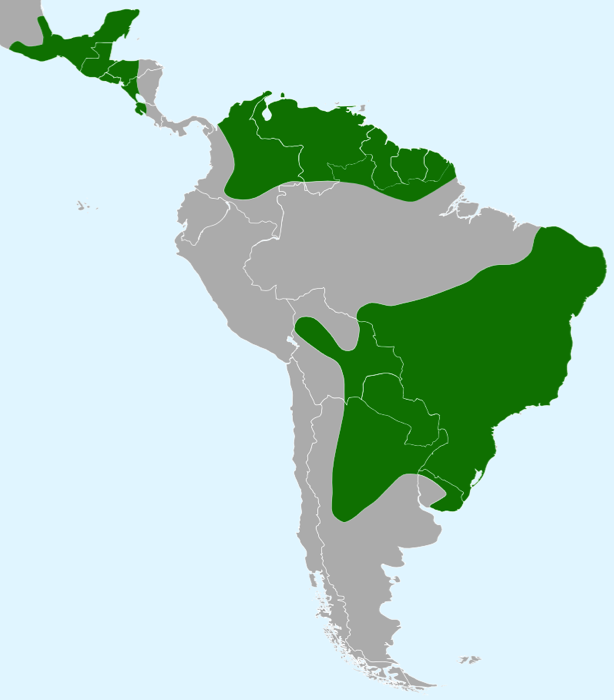South American Rattlesnake
South American Rattlesnake
Rattlesnakes are among the most iconic snakes of the Americas. However, they're not restricted to just North America. Central and South America have their own versions too. The neotropical rattlesnake (AKA: South American rattlesnake) is found across almost all South American countries.
South American Rattlesnake
- Venezuelan rattlesnake - C. d. cumanensis
- Guyana rattlesnake - C. d. durissus
- Marajon rattlesnake - C. d. marajoensis
- Maricela rattlesnake - C. d. maricelae
- Mount Roraima rattlesnake - C. d. ruruima
- Cascavel - C. d. terrificus
- Rupunini rattlesnake - C. d. trigonicus
- Aruba Island rattlesnake - C. d. unicolor
- Uracoan rattlesnake - C. d. vegrandis
Appearance
- Older individuals will sometimes also have a raised dorsal ridge.
- Males are slightly larger than females.
- Although the "rattle" on South American rattlesnake species isn't as large as that of their northern cousins, its still functional and visible.
- The scales have a rough or beaded texture in contrast to that of most other south american snakes.
Scientific Name
Crotalus durissus terrificus

Local Name
Cascavel

Description
Thick and stocky snake measuring around 1.5 m in length when adult. Dark green or brown with prominent zig-zag or diamond patterning along the back. Scales have a rough or beaded appearance.
Venom and Bites
The chemical make-up and proportion of toxins within cascavel venom has been found to vary slightly depending on the region and the age of the snake. Bites have have been known to result in blindness or impaired vision, auditory problems, or paralysis of peripheral muscles. Skeletal and heart muscles can also be affected causing aches, pain and tenderness throughout the body. However, despite their lethal nature, snake venoms are also a treasure trove for medical research. Brazilian researchers have identified new proteins (such as crotamine) within the cascavel's venom - revealing potential uses to assist the fight against tumours, melanoma, and other cancers.
Behaviour and Habitat
Cascavels are largely nocturnal. Their peak activity occurs after sunset, between 6 and 9 pm, when its still warm and other nocturnal animals such as small rodents come out to to feed. The darkness helps the snakes to stay hidden while using their heat sensors to full advantage - locating and identifying prey. A common trick is to lie in wait along the trails that small mammals re-use on a frequent basis, quickly striking when their potential meal strays close. The snake will typically positioned themselves into an L-shape, allowing them to lunge at their prey simply by moving their head sideways rather than attempting to jump their body forwards. When striking, the long hinged fangs near the front of the cascavel's mouth are automatically pulled forward by their check muscles as their mouth opens wide. Prey is released after the strike, and is allowed to crawl away rather than allowing it to potentially damage the snake. The snake will pursue afterwards, eating it once it is dead.
Cascavels will also hunt occasionally in the day, but are more likely to spend their daytime hours resting in quiet refuges, or basking in the warmth of the sun to recharge their energy.
South American rattlesnake (cotalus durissus terrificus) displaying its thick stocky body and distinctive pattern. Photo: José Reynaldo da Fonseca.
Reproduction
Like other rattlesnakes, cascavels give are viviparous, giving birth to live young. This occurs around five months after mating, in the spring. The litter or clutch consists of 15-30 new-borns are fully venomous, independent - and able to start catching their own prey. The young snakes are preyed upon by hawks and other snakes (e.g. coral snakes). Should they reach adulthood, a typical lifespan is around 15 years, although they can live longer in captivity.
Conservation and Threats
Quick Facts
- Snake venom, including that of rattlesnakes, was a common means for native americans to produce poison for the arrows used in warfare. One method was to cause one or multiple snakes to bite into an animal liver (e.g. from a deer). This was left to putrefy and increase the toxicity. Arrow points were then smeared with the end product. It was said that one liver could poison a thousand arrowheads. Others tribes dipped their arrows directly into the venom glands of a recently-killed snake so that it dried like varnish.
- Native Mexican doctors used rattlesnake fangs as lancets, applied at the back of their patients' neck to relieve headaches.
- Brazil's Butantan Institute, founded in 1901, has a world-renowned reputation as a researcher and producer of anti-venoms, including that for South American rattlesnakes. The Institute was an important first-stop for explorers, such as Colonel Fawcett, to learn about the region's and stock up on anti-venoms before setting off into the wilds of Brazil.
Banner image: South American Rattlesnake (Shutterstock/Dmitri Gomon)

